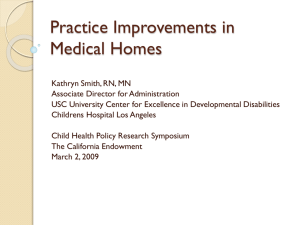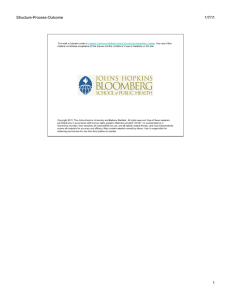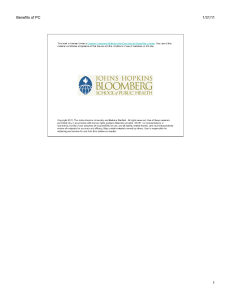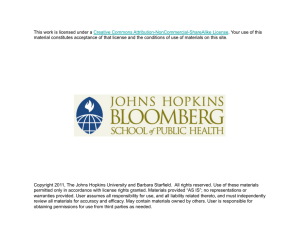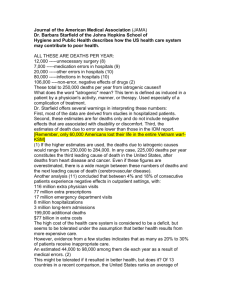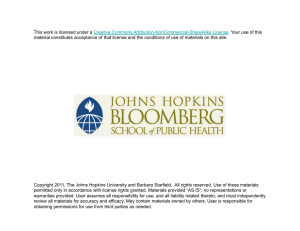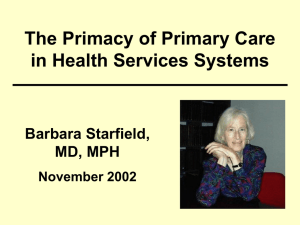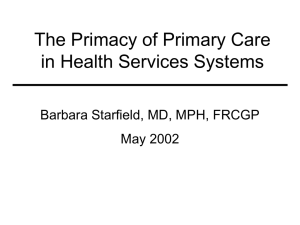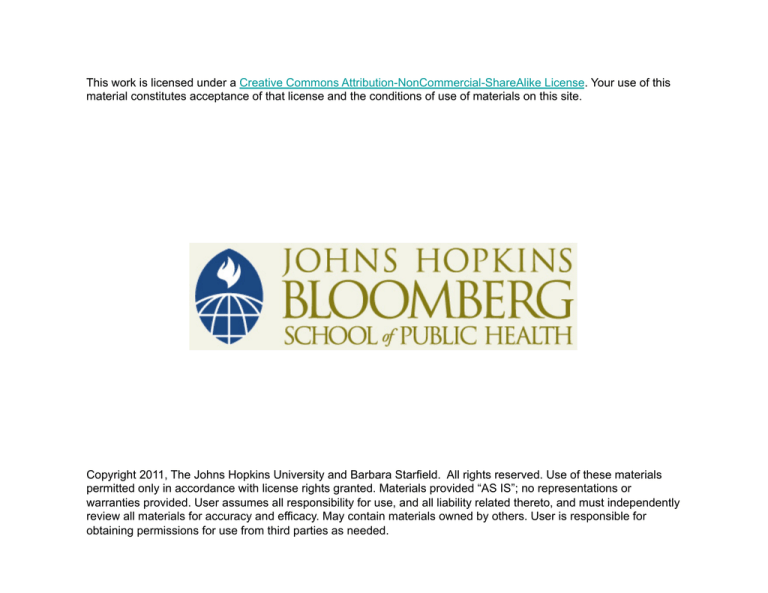
This work is licensed under a Creative Commons Attribution-NonCommercial-ShareAlike License. Your use of this
material constitutes acceptance of that license and the conditions of use of materials on this site.
Copyright 2011, The Johns Hopkins University and Barbara Starfield. All rights reserved. Use of these materials
permitted only in accordance with license rights granted. Materials provided “AS IS”; no representations or
warranties provided. User assumes all responsibility for use, and all liability related thereto, and must independently
review all materials for accuracy and efficacy. May contain materials owned by others. User is responsible for
obtaining permissions for use from third parties as needed.
Structure, Process, and
Outcome in Health
System Improvement
Barbara Starfield, MD, MPH
Avedis Donabedian Award
in Quality Improvement Session
(Washington, DC, 2007)
Revolutions in Medicine, 1900s
Ascendance of single disease and chronic
illness focus
Diagnostic challenges/more technology
Single cause (? gene) – magic bullet
All fostered an INDIVIDUAL ORIENTATION
in health services.
Starfield 07/07
LINK 5937
Revolutions in Medicine, 2000s
Multiple interacting influences on illness/
health
Disparities in health (inequity)
Illness as morbidity burden, not as disease
Risk factors as diseases
Health as an impossibility (a healthy person
is someone without enough tests)
All require a POPULATION ORIENTATION.
Starfield 07/07
LINK 5938
Country* Clusters: Health Professional
Supply and Child Survival
Starfield 07/07
HS 6333 n
Global Health Chart
Source: Karolinska Institute: www.whc.ki.se/index.php. All Rights Reserved.
Starfield 09/04
IC 5644 n
Life Expectancy Compared with GDP
per Capita for Selected Countries
Starfield 11/06
IC 6440 n
Are there differences in
structure, process, and
outcomes that can explain
variability in health even
across areas with similar
wealth and resources?
Starfield 10/07
IH 6847
Societal Influences on Population Health and Equity
COMMUNITY CONTEXT
notes continued on IH 6891 bn
ENVIRONMENTAL
CHARACTERISTICS
POLICY CONTEXT
OCCUPATIONAL &
ENVIRONMENTAL
POLICY
POLITICAL
CONTEXT
SOCIAL
POLICY
EQUITY IN
HEALTH*
WEALTH: LEVEL &
DISTRIBUTION
POWER/STATUS
RELATIONSHIPS
HISTORICAL
HEALTH
DISADVANTAGE
RATES OF DISCOMFORT
AND DISEASE
ECONOMIC
POLICY
BEHAVIORAL &
CULTURAL
CHARACTERISTICS
RATES OF DISABILITY
AND DEATH
HEALTH
POLICY
HEALTH SYSTEM
CHARACTERISTICS
Dashed lines indicate the existence of pathways through individual-level
characteristics that most proximally influence health.
Shading represents degree to which characteristics are measured at the ecological
level (lighter color) or at the individual level aggregated to community.
DEMOGRAPHIC
STRUCTURE
*“Health” has two aspects: occurrence
(incidence) and intensity (severity).
Starfield 01/08
IH 6891 an
Societal Influences on Population Health and Equity (continued)
COMMUNITY CONTEXT
notes continued from IH 6891 an
ENVIRONMENTAL
CHARACTERISTICS
POLICY CONTEXT
OCCUPATIONAL &
ENVIRONMENTAL
POLICY
POLITICAL
CONTEXT
SOCIAL
POLICY
EQUITY IN
HEALTH*
WEALTH: LEVEL &
DISTRIBUTION
POWER/STATUS
RELATIONSHIPS
HISTORICAL
HEALTH
DISADVANTAGE
RATES OF DISCOMFORT
AND DISEASE
ECONOMIC
POLICY
BEHAVIORAL &
CULTURAL
CHARACTERISTICS
RATES OF DISABILITY
AND DEATH
HEALTH
POLICY
HEALTH SYSTEM
CHARACTERISTICS
Dashed lines indicate the existence of pathways through individual-level
characteristics that most proximally influence health.
Shading represents degree to which characteristics are measured at the ecological
level (lighter color) or at the individual level aggregated to community.
DEMOGRAPHIC
STRUCTURE
*“Health” has two aspects: occurrence
(incidence) and intensity (severity).
Starfield 01/08
IH 6891 bn
A framework based on
structure, process, and
outcome is helpful in
describing and measuring
the components of health
services systems.
Starfield 10/07
HS 6849
The Health Services System
CAPACITY
Provision
of care
PERFORMANCE
Personnel
Facilities and equipment
Range of services
Organization
Management and amenities
Continuity/information systems
Knowledge base
Accessibility
Financing
Population eligible
Governance
Problem recognition
Diagnosis
Management
Reassessment
Community
resources
Cultural and
behavioral
characteristics
People/practitioner interface
Receipt
of care
HEALTH STATUS
(outcome)
Biologic endowment
and prior health
Source: Starfield. Primary Care:
Balancing Health Needs, Services, and
Technology. Oxford U. Press, 1998.
Utilization
Acceptance and satisfaction
Understanding
Participation
Longevity
Comfort
Perceived well-being
Disease
Achievement
Risks
Resilience
Social, political,
economic, and
physical
environments
Starfield 02/09
HS 5064 n
Primary care is a major
component of health
services systems.
Starfield 10/07
HS 6850
Primary Health Care and
Primary Care
Primary health care is a system-wide
approach to designing health services
based on primary care.
Primary care is the representation, on
the clinical level, of primary health care.
Starfield 03/05
PC 6384
The framework of structure,
process, and outcome is
useful in defining primary
care so that it can be
measured and evaluated.
Starfield 10/07
EVAL 6856
Primary Care
First Contact
• Accessibility
• Use by people for each new problem
Longitudinal
• Relationship between a facility and its
population
• Use by people over time regardless of the type
of problem; person-focused character of
provider/patient relationship
Comprehensive
• Broad range of services
• Recognition of situations where services are
needed
Coordination
• Mechanism for achieving continuity
• Recognition of problems that require follow-up
Starfield 02/08
EVAL 5102 n
Structural and Process Elements of the
Essential Features of Primary Care
Capacity
Accessibility
Essential Features
Performance
First-contact
Utilization
Eligible population
Longitudinality
Range of services
Comprehensiveness
Person-focused
relationship
Problem recognition
Continuity
Coordination
Starfield 04/97
EVAL 5107 an
Primary Health Care Oriented Health Services Systems
CAPACITY
Provision
of care
PERFORMANCE
Receipt
of care
HEALTH STATUS
(outcome)
Biologic endowment
and prior health
Source: Starfield. Primary Care:
Balancing Health Needs, Services, and
Technology. Oxford U. Press, 1998.
Personnel
Facilities and equipment
Range of services
Organization
Management and amenities
Continuity/information systems
Knowledge base
Accessibility
Financing
Population eligible
Governance
Problem recognition
Diagnosis
Management
Reassessment
Community
resources
Cultural and
behavioral
characteristics
Population-Services interface
Utilization
Acceptance and satisfaction
Understanding
Participation
Longevity
Comfort
Perceived well-being
Morbidity burden
Achievement
Risks
Resilience
Social, political,
economic, and
physical
environments
Starfield 02/09
HS 6848 n
First Contact Care and Health Spending
Starfield 08/02
FC 5922 n
Benefits of Longitudinality (Person-centered over Time),
Based on Evidence from the Literature
Better problem/needs recognition
More accurate/earlier diagnosis
Better concordance
Appointment keeping
Treatment advice
Less ER use
Fewer hospitalizations
Lower costs
Better overall prevention
Better monitoring
Fewer drug prescriptions
Less unmet needs
Increased satisfaction
Identification
with a Person
++
++
++
++
++
++
++
++
+
+
++
++
Identification
with a Place
++
+
+
++
+
++Evidence good
+Evidence moderate
Source: Starfield. Primary Care: Balancing Health Needs,
Services, and Technology. Oxford U. Press, 1998.
Starfield 11/02
LONG 5290 n
Criteria for Comprehensiveness
In US studies: universal provision of extensive and
uniform benefits for children, the elderly, women, and
other adults; routine OB care; mental health needs
addressed; minor surgery; generic preventive care
In European studies: treatment and follow-up of diseases
(e.g., hypothyroidism, acute CVA, ulcerative colitis, workrelated stress, n=17); technical procedures (e.g., wart
removal, IUD insertion; removal of corneal rusty spot;
joint injections); taking cervical smears; group health
education; family planning and contraception
Sources: Starfield &Shi, Health Policy 2002; 60:201-18; Boerma et al, Br J
Gen Pract 1997; 47:481-6; Boerma et al, Soc Sci Med 1998; 47:445-53.
Starfield 10/07
COMP 6851
Coordination
Coordination requires transfer of information (a structural element)
and the recognition of that information in the ongoing care of a patient
(a process element).
Modes of transfer are multiple: conventional medical records, patientheld records; smart cards; electronic medical records; multidisciplinary
teams with specified complementary, supplementary, and substitutive
functions of each team member.
These different types have not been compared with regard to
effectiveness and efficiency, but developing countries (in particular)
are exploring the potential of community workers in assuming explicit
responsibility for a variety of primary care tasks in conjunction with
personnel in health centers where they exist.
Sources: Starfield, Primary Care: Balancing Health Needs, Services, and
Technology. Oxford U. Press, 1998. Brown, Lancet 2007; 370:1115-7.
Starfield 10/07
RC 6852
There are structural, process, and outcome
features that characterize primary HEALTH
care, that is, primary care at the policy level.
The critical structural features are equitable
distribution of resources (Personnel and
Facilities); government control or regulation of
financing and low or no copayments for primary
care services (Financing); and Definition of the
Eligible Population. A remaining question is the
extent of importance of mechanisms of
Governance, which have been poorly studied.
Starfield 10/07
EVAL 6853
Primary Care Scores, 1980s and 1990s
1980s
1990s
Belgium
France*
Germany
United States
0.8
0.5
0.2
0.4
0.3
0.4
0.4
Australia
Canada
Japan*
Sweden
1.1
1.2
1.2
1.1
1.2
0.8
0.9
Denmark
Finland
Netherlands
Spain*
United Kingdom
1.5
1.5
1.5
1.7
1.7
1.5
1.5
1.4
1.9
*Scores available only for the 1990s
Starfield 07/07
ICTC 5446 an
Primary Care Score vs. Health
Care Expenditures, 1997
UK
DK
NTH
SP
FIN
AUS
SWE
CAN
JAP
GER
BEL
FR
Based on data in Starfield & Shi, Health Policy 2002; 60:201-18.
US
Starfield 11/06
ICTC 5365 an
Relationship between Strength of Primary
Care and Combined Outcomes
USA
GER
BEL
AUS
SWE
CAN
SP
NTH
DK
FIN
UK
*1=best
11=worst
Source: Starfield. Primary Care: Balancing Health Needs,
Services, and Technology. Oxford U. Press, 1998.
Starfield 11/06
IC 5364 n
System (PHC) and Practice (PC) Characteristics
Facilitating Primary Care, Early-Mid 1990s
GER
FR
BEL
US
SWE
JAP
CAN
FIN
AUS
SP
DK
NTH
UK
*Best level of health indicator is ranked 1; worst is ranked 13;
thus, lower average ranks indicate better performance.
Based on data in Starfield & Shi, Health Policy 2002; 60:201-18.
Starfield 03/05
ICTC 5366 an
Primary health care oriented countries
• Have more equitable resource distributions
• Have health insurance or services that are
provided by the government
• Have little or no private health insurance
• Have no or low co-payments for health services
• Are rated as better by their populations
• Have primary care that includes a wider range
of services and is family oriented
• Have better health at lower costs
Sources: Starfield and Shi, Health Policy 2002; 60:201-18.
van Doorslaer et al, Health Econ 2004; 13:629-47.
Schoen et al, Health Aff 2005; W5: 509-25.
Starfield 11/05
IC 6311
Key system factors in achieving primary
health care in both developing and
industrialized countries are:
• Universal financial coverage, under
governmental control or regulation
• Efforts to distribute resources
equitably (according to degree of
need)
• No or low co-payments
• Comprehensiveness of services
Sources: Starfield & Shi, Health Policy 2002; 60:201-18.
Gilson et al, Challenging Inequity through Health Systems
(
http://www.who.int/social_determinants/resources/csdh_media/
hskn_final_2007_en.pdf; accessed March 17, 2009).
Starfield 07/07
GH 6739 n
Studies in other developing and middle income
countries also show benefit from primary care
reform.
• In Bolivia, reform in deprived areas lowered
under-5 mortality rates compared with
comparison areas.
• In Costa Rica, primary care reforms in the 1990s
decreased infant mortality and increased life
expectancy to rates comparable to those in
industrialized countries.
• In Mexico, improvements in primary care
practices reduced child mortality in socially
deprived areas.
Sources: Perry et al, Health Policy Plann 1998; 13:140-51; Reyes et al, Health Policy Plann 1997; 12:214-23;
Rosero-Bixby, Rev Panam Salud Publica 2004; 15:94-103; Rosero-Bixby, Soc Sci Med 2004; 58:1271-84.
Starfield 08/05
WC 6451
Many other studies done WITHIN countries,
both industrialized and developing, show that
areas with better primary care have better
health outcomes, including total mortality
rates, heart disease mortality rates, and
infant mortality, and earlier detection of
cancers such as colorectal cancer, breast
cancer, uterine/cervical cancer, and
melanoma. The opposite is the case for
higher specialist supply, which is associated
with worse outcomes.
Sources: Starfield et al, Milbank Q 2005;83:457-502.
Macinko et al, J Ambul Care Manage 2009;32:150-71.
Starfield 09/04
WC 6314
What We Already Know
A primary care oriented system is
important for
• Improving health (improving
effectiveness)
• Keeping costs manageable (improving
efficiency)
Starfield 09/05
PC 6303
Does primary care
reduce inequity in
health?
Starfield 07/07
EQ 6323 n
Equity in health is the absence
of systematic and potentially
remediable differences in one
or more aspects of health
across population groups
defined geographically,
demographically, or socially.
Source: www.iseqh.org
Starfield 07/07
EQ 5683 n
In the United States, an increase of
1 primary care doctor is associated
with 1.44 fewer deaths per 10,000
population.
The association of primary care
with decreased mortality is greater
in the African-American population
than in the white population.
Source: Shi et al, Soc Sci Med 2005; 61(1):65-75.
Starfield 07/07
WCUS 5980 n
Percentage Reduction in Under-5
Mortality: Thailand, 1990-2000
Poorest quintile (1) 44
(2) 41
(3) 22
(4) 23
Richest quintile (5) 13
Rate ratio (Q1/Q5) 55
Absolute difference 61
(Q1-Q5)
Source: Vapattanawong et al, Lancet 2007; 369:850-5.
Policy changes:
1989 At least one primary care health
center for each rural village
1993 Government medical welfare
scheme: all children less than 12,
elderly, disabled
2001 Entire adult population insured
Activities of Rural Doctors’ Society
Starfield 07/07
WC 6700 n
In 7 African countries
• The highest 1/5 of the population receives
well over twice as much financial benefit
from overall government health spending
(30% vs 12%).
• For primary care, the poor/rich benefit ratio
is much lower (23% vs 15%).
“From an equity perspective, the move
toward primary care represents a clear step
in the right direction.”
Source: Gwatkin, Int J Epidemiol 2001; 30:720-3, based on
Castro-Leal et al, Bull World Health Organ 2000; 78:66-74.
Starfield 03/04
IC 5751
Share of Public Spending on Health among
Countries with Similar GNP per Capita But Very
Disparate Child Survival (to Age 5) Rates, 1995
Ratio*: percent of expenditures for health from the government to
poorest 20% vs. richest 20% of population
High child survival
Low child survival
Additional children
lost per 1000
Sri Lanka
1.1
Ivory Coast
0.3
150
Malaysia
2.6
Brazil
0.4
45
Costa Rica
2.1
South Africa
0.9
55
Jamaica
3.3
Ecuador
0.2
25
Nicaragua
1.0
India
0.3
50
Egypt
0.6
Ivory Coast
0.3
100
*Ratios of one or more signify a greater share of government expenditures
to poorest segment of population.
Sources: Calculated from Karolinska Institute, Global health chart, www.whc.ki.se/index.php. Victora
et al, Lancet 2003; 362:233-241. Castro-Leal et al, Bull World Health Organ 2000; 78:66-74. Carr.
Improving the Health of the World's Poorest People. Population Health Bureau, 2004.
Starfield 09/04
IC 6234 n
System Features Important to Primary Health Care
Resource
Allocation Progressive
Cost
Compre(Score)
Financing* Sharing hensiveness
Belgium
France
Germany
US
0
0
0
0
0
0
1
0**
0
0
2
0
0
0
0
0
Australia
Canada
Japan
Sweden
1
1
1
2
2
2
2
2
2
2
1
1
2
2
1
1
Denmark
Finland
Netherlands
Spain
UK
2
2
2
2
2
2
2
0
2
2
2
1
2
2
2
2
2
2
1
2
Sources: Starfield. Primary Care: Balancing Health Needs, Services, and
Technology. Oxford U. Press, 1998. van Doorslaer et al. Equity in the Finance and
Delivery of Health Care: An International Perspective. Oxford U. Press, 1993.
*0=all regressive
1=mixed
2=all progressive
**except Medicaid
Starfield 11/06
EQ 5599 n
Primary Care and Health:
Evidence-Based Summary
• Countries with strong primary care
– have lower overall costs
– generally have healthier populations
• Within countries
– areas with higher primary care physician
availability (but NOT specialist availability) have
healthier populations
– more primary care physician availability reduces
the adverse effects of social inequality
Starfield 09/02
PC 5485 n
For outcomes, the imperative is
to replace the primary focus on
DISEASE with a focus on
ILLNESS, substituting a multidomain conceptualization for a
disease-by-disease accounting
of health statistics.
Starfield 10/07
EVAL 6854
Diseases
• are professional constructs
• can be and are artificially created to suit
special interests; the sum of deaths
attributed to diseases exceeds the number
of deaths
• do not exist in isolation from other
diseases and are, therefore, not an
independent representation of illness
• are but one manifestation of ill health
Sources: Chin. The AIDS Pandemic: the Collision of Epidemiology with Political Correctness.
Radcliffe Publishing, 2007. De Maeseneer et al. Primary Health Care as a Strategy for Achieving
Equitable Care: a Literature Review Commissioned by the Health Systems Knowledge Network.
WHO Health Systems Knowledge Network, 2007. Available at:
http://www.who.int/social_determinants/resources/csdh_media/primary_health_care_2007_en.pdf.
Mangin et al, BMJ 2007; 335:285-7. Murray et al, BMJ 2004; 329:1096-1100. Tinetti & Fried, Am J
Med 2004; 116:179-85. Walker et al, Lancet 2007; 369:956-963. Rosenberg, Milbank Q
2002;80:237-60. Moynihan & Henry, PLoS Med 2006;3:e191.
Starfield 08/07
D 6812
Primary Health Care Oriented Health Services Systems
CAPACITY
Provision
of care
PERFORMANCE
Receipt
of care
HEALTH STATUS
(outcome)
Biologic endowment
and prior health
Source: Starfield. Primary Care:
Balancing Health Needs, Services, and
Technology. Oxford U. Press, 1998.
Personnel
Facilities and equipment
Range of services
Organization
Management and amenities
Continuity/information systems
Knowledge base
Accessibility
Financing
Population eligible
Governance
Problem recognition
Diagnosis
Management
Reassessment
Community
resources
Cultural and
behavioral
characteristics
Population-Services interface
Utilization
Acceptance and satisfaction
Understanding
Participation
Longevity
Comfort
Perceived well-being
Morbidity burden
Achievement
Risks
Resilience
Social, political,
economic, and
physical
environments
Starfield 02/09
HS 6848 n


